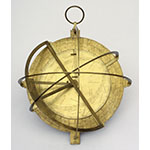The instrument, made by Charles Whitwell, consists of two superposed disks. On the front of the larger one is the maker's signature and a slit that may have served to fasten it to a support. On its rim are four diametrically opposing prominences carrying two right-angled semi-armillae. One of the prominences holds a suspension ring. Two other semi-armillae—one of which can be tilted—are attached to the four similar prominences on the smaller disk and rotate together with the latter around the center of the instrument. A diopter, pivoting on the center of the smaller disk, was used for sighting. This nautical hemisphere probably served to compute tides and is derived from a model invented by Michel Coignet c. 1580. Provenance: Robert Dudley bequest to the Medici collections.










